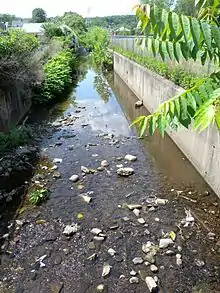Urban stream
An urban stream is a formerly natural waterway that flows through a heavily populated area. Urban streams are often polluted by urban runoff and combined sewer outflows.[1] Water scarcity makes flow management in the rehabilitation of urban streams problematic.[2]

Governments may alter the flow or course of an urban stream to prevent localized flooding by river engineering: lining stream beds with concrete or other hardscape materials, diverting the stream into culverts and storm sewers, or other means. Some urban streams, such as the subterranean rivers of London, run completely underground. These modifications have often reduced habitat for fish and other species, caused downstream flooding due to alterations of flood plains, and worsened water quality.[3]

Some communities have begun stream restoration projects in an attempt to correct the problems caused by alteration, using techniques such as daylighting and fixing stream bank erosion caused by heavy stormwater runoff.[4][5] Streamflow augmentation to restore habitat and aesthetics is also an option, and recycled water can be used for this purpose.[6][7]
See also
- Nationwide Urban Runoff Program (NURP) – US research program
- Nonpoint source pollution
- Subterranean river
References
- Walsh, Christopher J. et al.(2005)."The urban stream syndrome: current knowledge and the search for a cure." Journal of the North American Benthological Society, 2005, 24(3):706–723. doi:10.1899/04-028.1, ISSN 0887-3593
- Lawrence, J.E., C.P.W. Pavia, S. Kaing, H.N. Bischel, R.G. Luthy, and V.H. Resh (2014). "Recycled Water for Augmenting Urban Streams in Mediterranean-climate Regions: A Potential Approach for Riparian Ecosystem Enhancement". Hydrological Sciences Journal. 59 (3–4): 488–501. doi:10.1080/02626667.2013.818221. S2CID 129362661.CS1 maint: multiple names: authors list (link)
- National Management Measures to Control Nonpoint Source Pollution from Hydromodification (Report). Washington, DC: U.S. Environmental Protection Agency (EPA). July 2007. EPA 841-B-07-002.
- California Department of Water Resources. "Urban Streams Restoration Program". Retrieved 2009-07-11.
- Revkin, Andrew C. (16 July 2009). "Rolling Back Pavement to Expose Watery Havens". New York Times. Retrieved 19 July 2009.
- Bischel, H.N., J.E. Lawrence, B.J. Halaburka, M.H. Plumlee, A.S. Bawazir, J.P. King, J.E. McCray, V.H. Resh, and R.G. Luthy (2013). "Renewing Urban Streams with Recycled Water for Streamflow Augmentation: Hydrologic, Water Quality, and Ecosystem Services Management". Environmental Engineering Science. 30 (8): 455–479. doi:10.1089/ees.2012.0201.CS1 maint: multiple names: authors list (link)
- Halaburka, B.J., J.E. Lawrence, H.N. Bischel, M.H. Plumlee, J. Hsiao, V.H. Resh, and R.G. Luthy (2013). "Economic and Ecological Costs and Benefits of Streamflow Augmentation using Recycled Water in a California Coastal Stream". Environmental Science & Technology. 47 (19): 10735–10743. Bibcode:2013EnST...4710735H. doi:10.1021/es305011z. PMID 23688175.CS1 maint: multiple names: authors list (link)
Bibliography
- Riley, Ann L.; Leopold, Luna B. (1998). Restoring Streams in Cities: A Guide for Planners, Policymakers, and Citizens. Washington, DC: Island Press. ISBN 978-1-55963-042-9.
External links
- Urban Waters Program - U.S. Environmental Protection Agency (EPA)
- Ecosystem Effects of Urban Stream Restoration - EPA